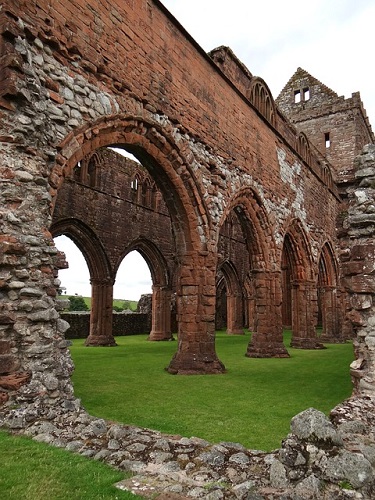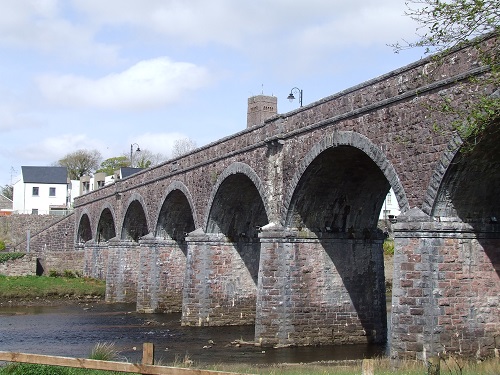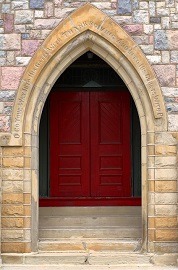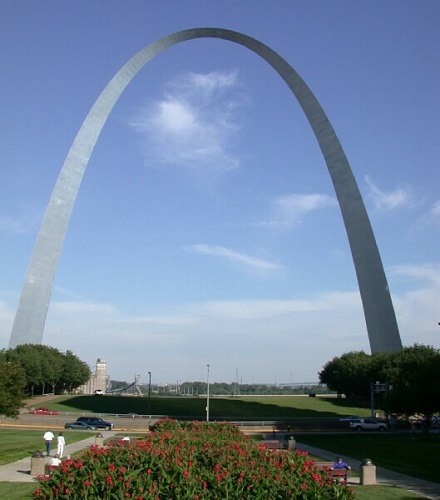Arches
Contents |
[edit] Introduction
An arch is a curved structural form that carries loads around an opening, transferring them around the profile of the arch to abutments, jambs or piers on either side.
Arches have been a prominent feature in architecture since the time of the Etruscans who are credited with its invention, although the Romans developed it further and spread its use. The techniques involved in designing and constructing arches have since developed into many other structural forms, including vaults, arcades and bridges.
Arches are compressive structures, that is, there are no tensile stresses. They are self-supporting, stabilised by the force of gravity acting on their weight to hold them in compression. This makes them very stable and efficient, capable of larger spans, and supporting greater loads than horizontal beams.
The downward load of an arch must be transferred to its foundations. The outward thrust exerted by an arch at its base must be restrained, either by its own weight or the weight of supporting walls, by buttressing or foundations, or by an opposing tie between the two sides. The outward thrust increases as the height, or rise, of the arch decreases.
[edit] Arch construction
Since many building materials, such as masonry and concrete, can resist compression, arches are commonly constructed using these types of material.
The construction of traditional masonry arches is dependent on the arrangement of the bricks, blocks or stones over the opening. Wedge-shaped blocks, called voussoirs, are set flank-to-flank with the upper edge being wider than the lower edge. Downward pressure on the arch has the effect of forcing the voussoirs together instead of apart. The voussoir that is positioned in the centre of the arch is known as the keystone.
This arrangement means that the arch is self-supporting, but temporary supports from below, usually in the form of timber 'centres' (sometimes called 'centreing' or 'arch formers'), must be provided until the keystone has been set in place.
The interior, lower curve of the arch is known as the intrados. The exterior, upper curve of the arch is known as the extrados. The spring, or springing line, is the point from which the arch starts to rise from its vertical supports.
[edit] Types of arch
Most arches are circular, pointed or parabolic, however, there are a great many variations of these basic forms that have developed during different periods. Ancient Roman architects favoured rounded arches, whereas Gothic architects preferred pointed arches and in this respect may have been influenced by Islamic architecture.
Some of the most common types of arch are described below.
[edit] Triangular arch
First developed by the Mayans, the triangular arch is formed by two large diagonal stones that span an opening by mutually supporting each other.
[edit] Round arch
Also known as a semi-circular arch, this is formed in a continuous curve and was developed by the Romans. They were often used side by side in a series to create an arcade. An adaptation is the rampant round arch which has unequal lengths of support on either side.
[edit] Segmental arch
This is an arch that has a rise that is less than a semi-circle. In a flatter form, segmental arches were commonly used for bridges as larger spans are possible without excessively increasing height. Since the flatter the arch gets the more thrust is delivered sideways to the abutments, there bridges require large abutments at either side.
[edit] Lancet arch
This was a form of pointed arch that was developed during the Gothic period. It was often used for windows and roof structures in churches and cathedrals. The arch is tall and narrow with a pointed apex.
[edit] Equilateral arch
Also from the Gothic period, equilateral arches were often used for decorative entrances and windows. The two springing points and the crown of the intrados form an equilateral triangle, meaning that each curve has a chord length equal to the span.
[edit] Camber arch
Also known as a jack arch, a camber arch is similar to a lintel in that it is flat, or almost flat, in profile, however, the voussoirs use their compressive strength in the same way as a regular arch.
[edit] Trefoil arch
The trefoil arch was commonly used in religious buildings, and incorporated the shape of three overlapping rings, known as a trefoil.
[edit] Horseshoe arch
The curves of the horseshoe arch bulge out from the springing points to create a horseshoe profile. They were widely used in Islamic architecture in regions such as Spain and North Africa.
[edit] Three-centred arch
The three-centred arch is similar to the segmental arch but has more than two centres, providing it with an elliptical or oval profile.
[edit] Four-centred arch
The four-centred arch, also known as a Tudor arch or depressed arch, is low and wide with a pointed apex. It is normally much wider than its rise and was commonly used in English architecture.
[edit] Ogee arch
The ogee arch form was developed during the English Gothic period and follows a concave arc that flows into a convex arc with pointed crown. It was often used for decorative purposes above doorways.
[edit] Parabolic and catenary arch
A parabolic arch follows the principle that when there is a uniformly applied load from above, the internal compression that results will follow a parabolic curve. Parabolic arches produce the most thrust at the base, but can span the greatest distance, and so are commonly used in bridge design.
A catenary arch looks very similar to a parabola, but is slightly more 'flat' at the bottom, and rises faster than the parabola. The catenary is the solution to a differential equation that describes a shape that directs the force of its own weight along its own curve, so that, if hanging, it is pulled into that shape, and if standing upright it can support itself. The parabola does not have the same property, but is the solution of other important equations that describe other situations.
The Gateway Arch in St. Louis, Missouri, US (pictured above) is a catenary arch.
[edit] Related articles on Designing Buildings
- Abutment.
- Aqueduct.
- Arcade.
- Arch brick.
- Barrel vault.
- Blind arch.
- Bridge construction.
- Camber arch.
- Cloister.
- Compressive strength.
- Corbel.
- Dogtooth.
- Extrados.
- Gateway Arch.
- Hood mould.
- Hyperbolic paraboloid.
- Long span roof.
- Masonry.
- Ogive.
- Optimal arch bridge.
- Piers.
- Portal frame.
- Segmental arch.
- Shell roof.
- Soffit.
- Types of ceiling.
- Types of dome.
- Types of structural load.
- Vault.
- Voussoir.
[edit] External references
- 'Building construction handbook' (6th ed.), CHUDLEY, R., GREENO, R., Butterworth-Heinemann (2006)
Featured articles and news
Deputy editor of AT, Tim Fraser, discusses the newly formed society with its current chair, Chris Halligan MCIAT.
Barratt Lo-E passivhaus standard homes planned enmasse
With an initial 728 Lo-E homes across two sites and many more planned for the future.
Government urged to uphold Warm Homes commitment
ECA and industry bodies write to Government concerning its 13.2 billion Warm Homes manifesto commitment.
Places of Worship in Britain and Ireland, 1929-1990. Book review.
The emancipation of women in art.
CIOB Construction Manager of the Year 2025
Just one of the winners at the CIOB Awards 2025.
Call for independent National Grenfell oversight mechanism
MHCLG share findings of Building Safety Inquiry in letter to Secretary of State and Minister for Building Safety.
The Architectural Technology Awards
AT Awards now open for this the sixth decade of CIAT.
50th Golden anniversary ECA Edmundson awards
Deadline for submissions Friday 30 May 2025.
The benefits of precast, off-site foundation systems
Top ten benefits of this notable innovation.
Encouraging individuals to take action saving water at home, work, and in their communities.
Takes a community to support mental health and wellbeing
The why of becoming a Mental Health Instructor explained.
Mental health awareness week 13-18 May
The theme is communities, they can provide a sense of belonging, safety, support in hard times, and a sense purpose.
Mental health support on the rise but workers still struggling
CIOB Understanding Mental Health in the Built Environment 2025 shows.
Design and construction material libraries
Material, sample, product or detail libraries a key component of any architectural design practice.
Construction Products Reform Green Paper and Consultation
Still time to respond as consultation closes on 21 May 2025.
Resilient façade systems for smog reduction in Shanghai
A technical approach using computer simulation and analysis of solar radiation, wind patterns, and ventilation.




























